The late 19th century saw the development of smokeless powder, which replaced the traditional black powder with something that was more powerful, burned more consistently, and was hopefully safer. These powders were split into two categories: single-base powders that were based entirely on nitrocellulose and used by the US and France, and double-base powders that contained nitroglycerine as well, and were used by the British and Germans. Before the war, a number of ships were destroyed by internal explosions, but it was believed that these had mostly been solved.
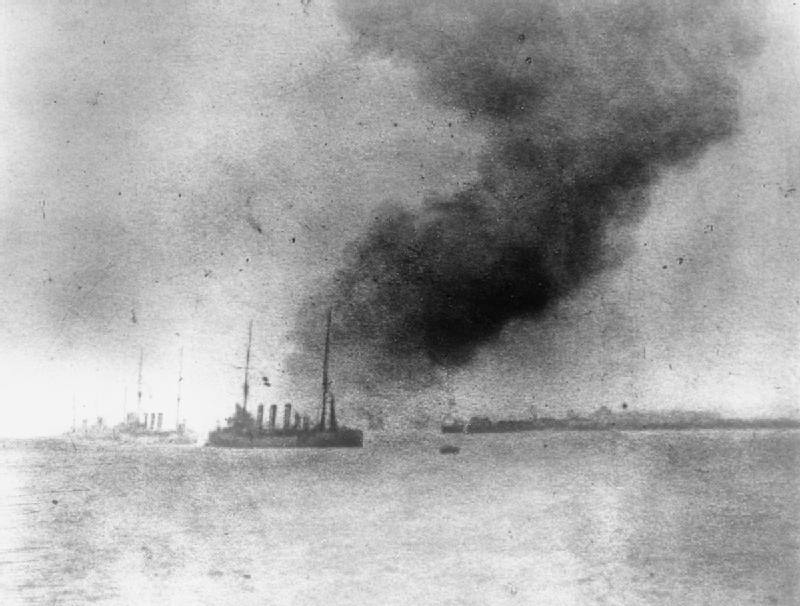
HMS Bulwark explodes
Unfortunately, this was not the case. The first warning came to the British in November 1914, just after the outbreak of war, when the pre-dreadnought Bulwark exploded after some cordite charges were left against the boiler-room bulkhead, killing all but a dozen men onboard. Neither this nor various prewar explosions nor the loss of the armored cruiser Natal a year later to a similar explosion were enough to shake British confidence in their cordite, as they had run a number of tests which seemed to confirm its safety. None involved a reasonable quantity of cordite in a confined space, an oversight that would prove disastrous on one day in 1916.
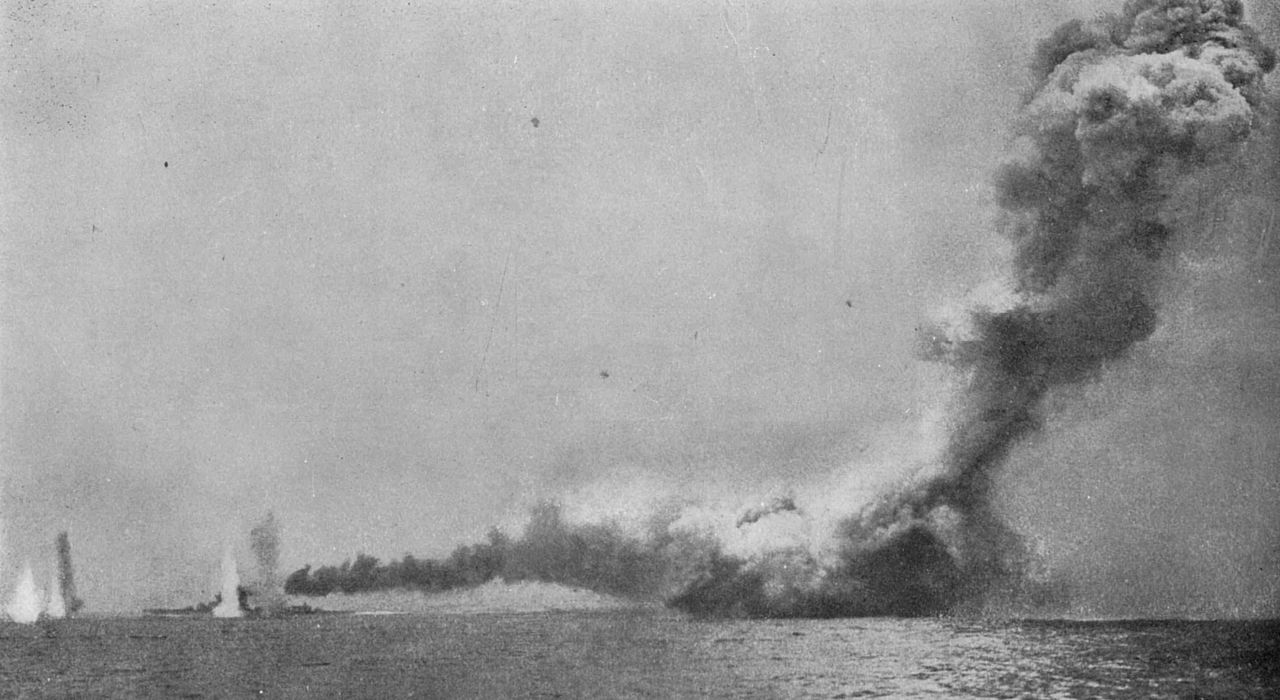
Battlecruiser Queen Mary explodes at Jutland
The loss of three battlecruisers and a pair of armored cruisers was enough to force the British to take a careful look at their cordite.1 They discovered that the existing propellant was indeed dangerously unstable, and devised a new MC (modified cracked) cordite, substituting cracked mineral jelly for the petroleum jelly they'd previously used and tightening up quality control. 6,000 tons of old, unstable cordite was to be removed from the fleet's magazines and replaced, but even this was too slow to save the battleship Vanguard, lost in July 1917 with all but two of her crew to a spontaneous magazine explosion. This wasn't exclusively a British problem, as the Italians lost two battleships to magazine explosions and the Japanese one.
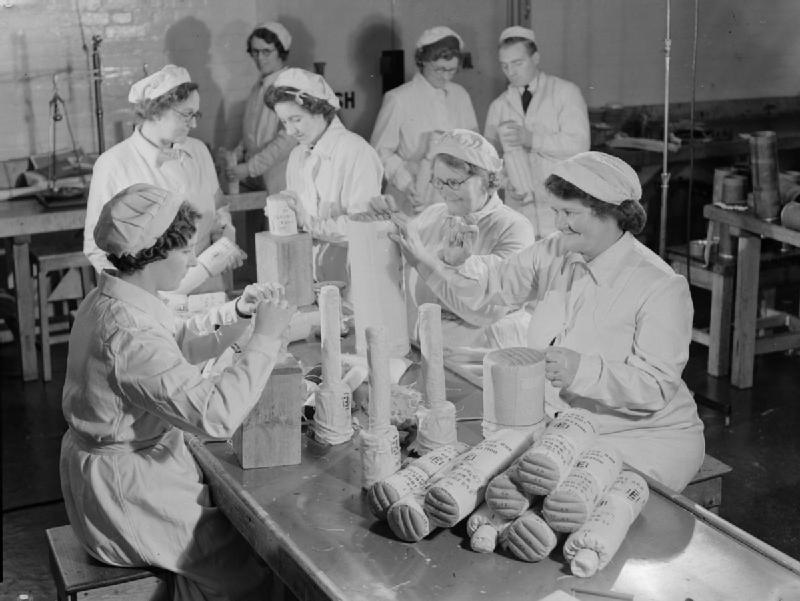
Women sew cordite bags in a factory
Postwar, the British discovered that the Germans had managed to make a major improvement in double-base powder, by dissolving the nitrocellulose in a mix of nitroglycerine and centralite. The centralite, unlike previous solvents, didn't have to be removed after the powder was extruded, and also served as a very effective stabilizer for the powder. As a result, a new cordite formulation was introduced in 1927, known as SC, for solventless cordite. Because the solvents didn't have to be removed, it was also possible to control the shape and size of the resulting strands much more accurately. SC was quite successful, and the British would continue to use it through the end of WWII. Similar powders were adopted by all major navies outside of the US.
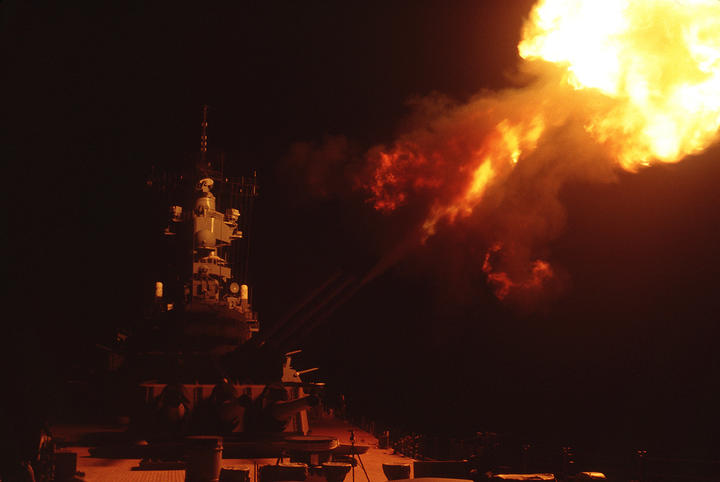
Muzzle flash from Wisconsin during Desert Storm
One drawback of SC, and of most powders in service at the end of WWI more generally, was that they produced large muzzle flashes, primarily from the combustion of gasses with atmospheric oxygen. This wasn't a problem during daytime actions, but it could give away a ship's position at night. The USN attempted to solve the problem with additives to their existing powder charges. They were successful, but the resulting charges produced a great deal of smoke, far too much for the searchlight control used at the time. The British had more success by developing an entirely new propellant, a triple-base concoction called NF using nitrocellulose, nitroglycerine, and nitroguanidine. NF was quite cool-burning, essentially eliminating flash, but also produced quite a bit of smoke, particularly because it was hard to ignite, requiring a larger black powder ignition charge. Nitroguanidine required a lot of electricity to make, and the only plant that produced NF was in Welland, Ontario, with ready access to hydroelectricity from Niagara Falls. One last drawback was that the charge required was larger than that for conventional cordite, so the largest British gun with a flashless charge was 6".
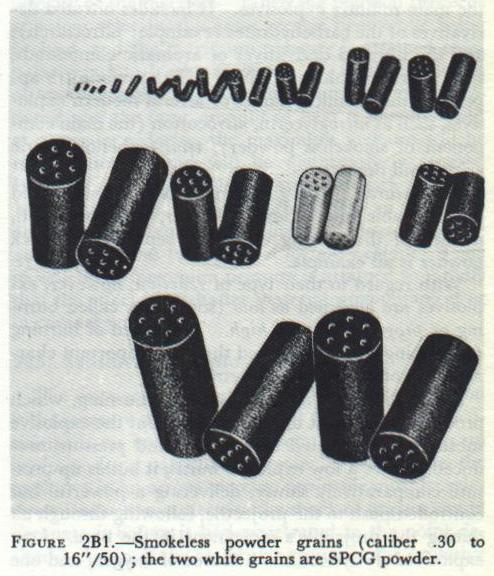
The advent of radar meant that the smoke from flashless powder was no longer nearly as much of a problem, and at the outbreak of WWII, the fleet again requested a truly flashless powder. As before, the Bureau of Ordnance responded first with pellets made of potassium nitrate and potassium sulfate that could be added to the vast stores of existing powder.2 These worked well enough, although only for smaller guns, and larger guns were supplied with Cordite N, another triple-base powder from Canada that produced less smoke. BuOrd didn't like Cordite N because it contained nitroglycerine,3 and they set about development of a powder based around dinitrodiethanol nitramine (DINA), nitroguandine and nitrocellulose. This was flashless, mostly smokeless, and the only real downside was that a charge of this Albanite (so called because the powder was white instead of red/black) was about 10% heavier than a nitrocellulose charge of the same power. Oh, and it wasn't actually ready for full-scale production until right around VJ Day, a year too late to be of much use.
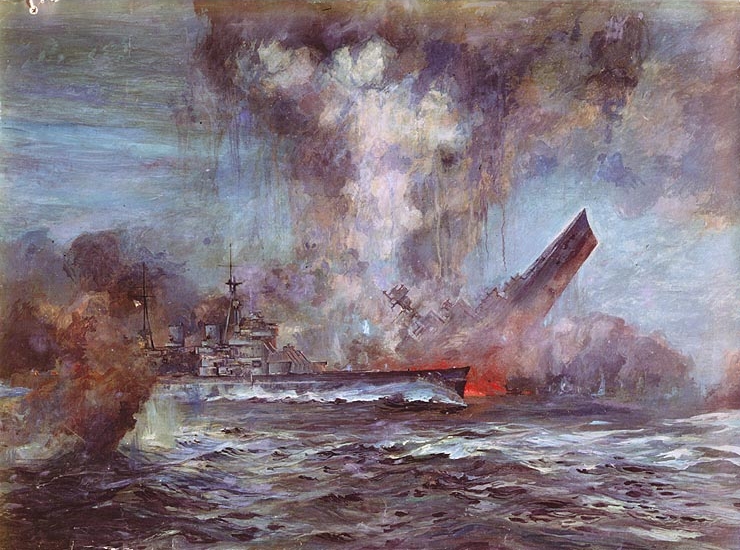
Hood sinks after a magazine explosion
In general, powder was safer during WWII than it had been in the previous war. Only one capital ship was lost to an accidental magazine explosion, the Japanese battleship Mutsu.4 But several ships did succumb to magazine hits. The most famous of these is probably Hood, blown up by Bismarck in a macabre echo of the destruction of the battlecruisers at Jutland. However, while the loss of those ships was due to horrible magazine safety practices, the loss of Hood appears to have been the result of an underwater shell hit, allowed to reach the magazine by an outdated armor scheme. The retention of cordite was another major factor, as tests showed it to be significantly more susceptible to accidental ignition than American powder. This is borne out by the experience of the cruiser Boise, who suffered a very similar magazine hit by a Japanese shell at Cape Esperance, but survived when water from the hit put out the fire before anything exploded.
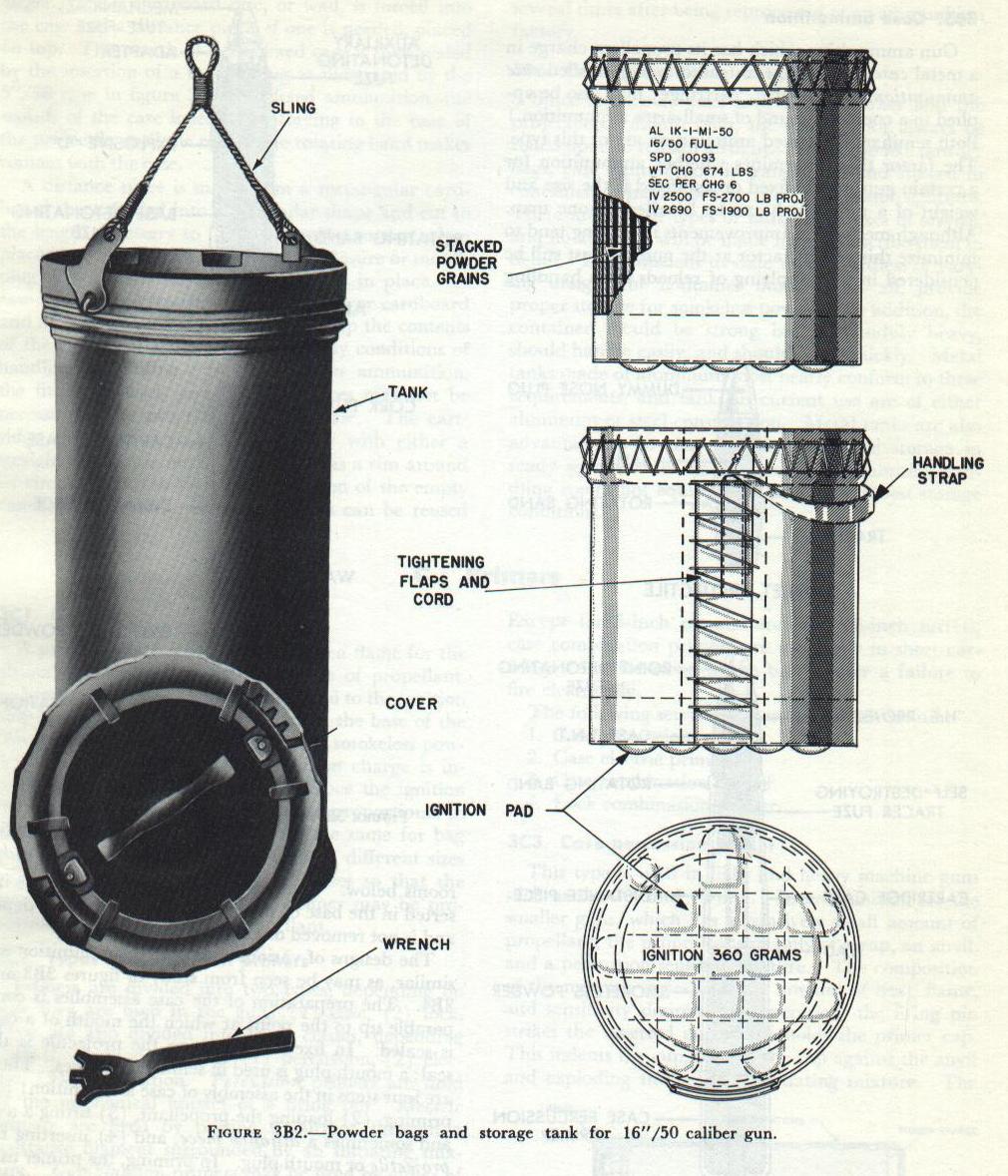
A similar story can be found with the Italian battleship Roma and American cruiser Savannah, both hit in the magazines by German guided bombs. Roma exploded, while flooding on Savannah put the fire out. But what of the one American magazine casualty, Arizona? The exact cause is still disputed. The oft-reported tale of a bomb going down the smokestack is false, as the cap was recovered intact. Some say that the bomb reached the 14" powder magazine itself, while others posit that it set off the black powder charges used for the saluting guns and the ship's catapults, which then ignited and set off the smokeless powder. The destruction of the blast renders it impossible to be sure either way.
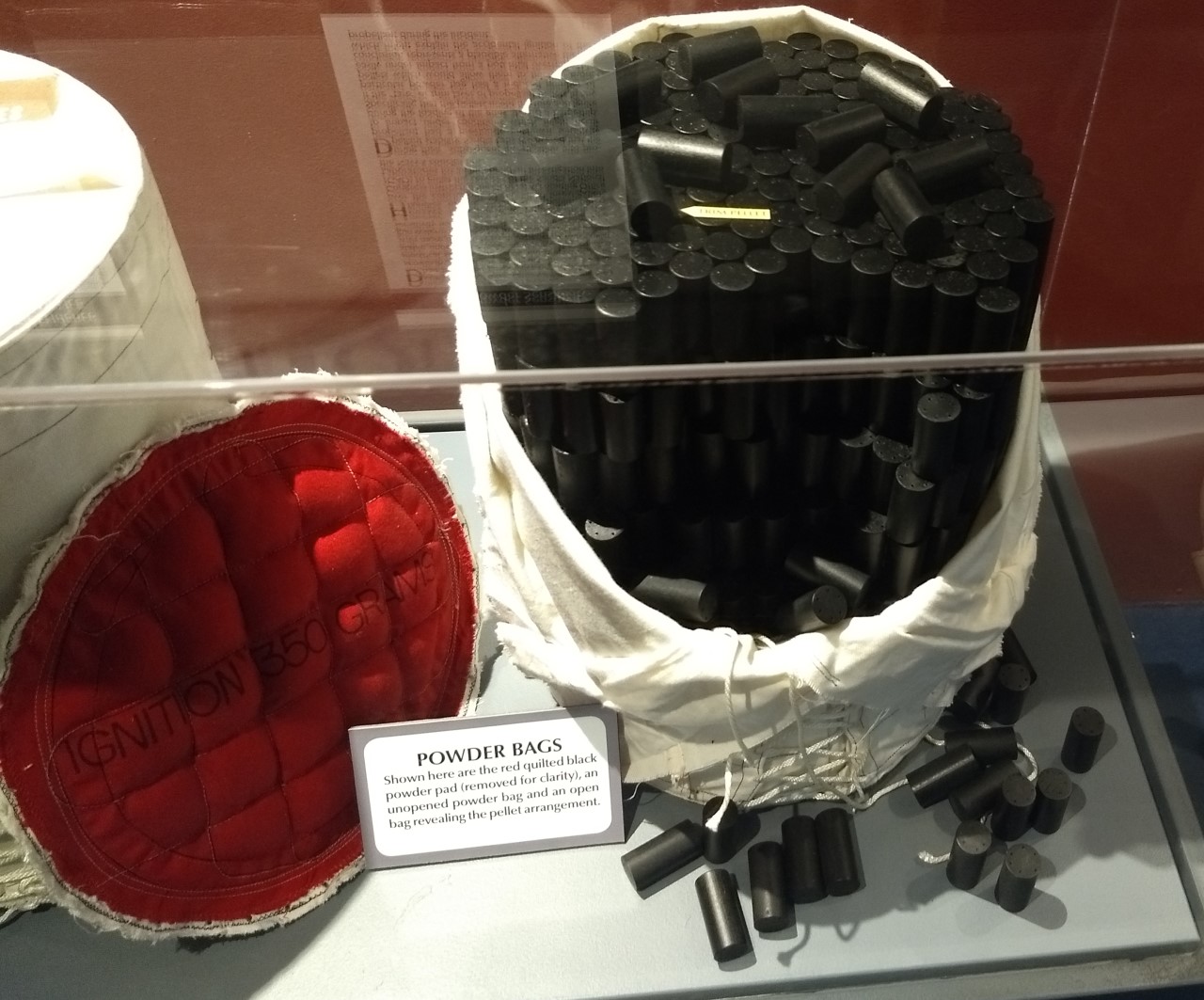
A section of one of Iowa's powder bags
And as usual with one of these tours, our last stop is the powder as actually used aboard the Iowa. It was a horn-like material that ranged in color from light amber to dark brown, darkening as the powder aged. No matter the size of the weapon, the chemical composition of the powder was the same. Guns below 40mm had grains with single perforations, while everything from the Bofors up to the 16" guns used grains with 7 perforations. To make quality control easier, the only variable was the size of the grains themselves.5 A 16" gun used grains that were 2" long and 1" wide, with 0.060" perforations and a web thickness between 0.193 and 0.197", depending on the exact formulation used. To ensure that the muzzle velocity was consistent, several lots of powder would be blended together and a sample test-fired to make sure that the powder in use matches the service standard. As loading a gun with loose powder would be extremely messy to say the least, the powder was sewn into silk bags.6 Each bag had eight layers of powder grains stacked end-to-end, with about 225 grains in each layer, and a tare layer of loose grains at one end to compensate for variations in weight, with an average of 15-65 grains.7 At the other end was the black powder igniter for the charge, which was quilted to ensure the powder was spread out properly and usually colored red to make sure it ended up in the back when the gun was loaded. The entire thing weighs 110 lb, and six bags were needed for one of Iowa's 16"/50 guns.8
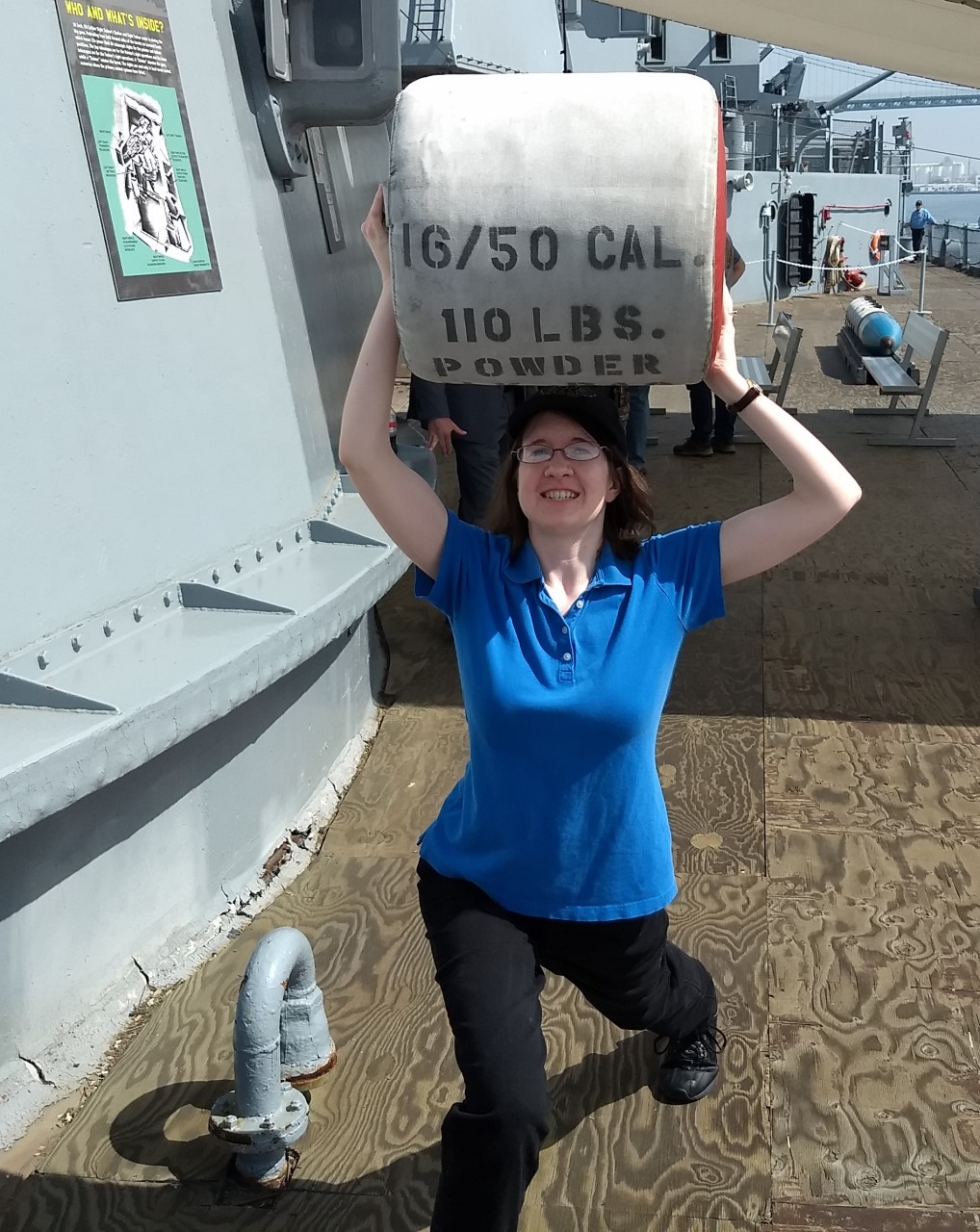
Lord Nelson hefts a 110-lb powder bag aboard Iowa
Throughout the history of naval gunnery, advancements in powder have been key to the ability to throw projectiles further and faster. After WWII, the pace of development slowed as guided missiles took over, but some work continued, and most guns today use triple-base powders that are low on both flash and smoke. There hasn't been much advancement in the field lately, but with the failure of railguns, it appears that powder is here to stay.
1 It's worth pointing out that the Germans also lost the pre-dreadnought Pommern to a similar magazine explosion. ⇑
2 Presumably these worked primarily by providing extra oxygen, so the gasses combusted inside the gun. Interestingly, almost all of the commercial producers of these pellets were drug companies. ⇑
3 Apparently, under certain very rare conditions the nitroglycerine in cordite could evaporate and end up somewhere it wasn't supposed to be. As pure nitroglycerine is incredibly difficult to deal with, I'm sort of amazed that the RN stuck with it as long as it did. ⇑
4 Technically, the Japanese report blamed sabotage, but it wouldn't be the first time that theory had been trotted out to explain a powder disaster. Nor would it be the last. Recent scholarship suspects a fire near the magazine raised the temperature of the black powder igniters enough to set them off. ⇑
5 The BuOrd history of WWII makes reference to the need for special charges for HC shells, because the lighter shells tended to make the powder burn improperly. The powder grains for these charges were apparently single-perforation, but I can't find any reference to them elsewhere. ⇑
6 Silk was used because it burns up completely and won't ignite the next charge when it is loaded. For added safety, air was blown into the breech after the gun was fired to clear any debris or remaining gas. ⇑
7 This is the layer that remains the leading candidate for the explosion on the Iowa. ⇑
8 Reduced charges were prepared of 52.5 lb each. These had similar powder grains, which were dumped in randomly. Each reduced charge was as long as a full charge to ensure proper spacing and ignition, but the diameter was reduced. ⇑

Comments
You don't mention whether the BBs lost to magazine explosions post-Dreadnaught were dreads or pre-dreads. But unless most of them are pre-dreads, it seems to me that a significant fraction of dreadnaughts were lost to magazine explosions in port, vs lost to combat with other dreadnaughts.
Vanguard was a dreadnought, as was one of the Italian ships. The other was a pre-dread, while the Japanese ship was extremely borderline. (It was all 12" guns, but a mix of 12"/50 and 12"/45, because madness.) Yes, this was a considerable fraction of all dreadnoughts lost, and possibly more than lost in pure capital ship engagements.
So, at present guns are obsolete and only put on warships to deal with merchantmen who are not worth an expensive missile or torpedo?
Not entirely. There are regular promises that new ammo will make guns competitive with missiles, although delivery on them has been poor. And they are definitely useful if you need to bombard something in support of an invasion or the like. But the main use case is indeed in a short-of-war situation. They're cheap enough and useful enough to be worth keeping around.
As mentioned in the articles on the re-commissioning of the battleships, one advantage of guns is that they are a bit more intimidating than missile tubes, especially VLS which are just about invisible. Of course downgrading from 16 inches to 5 inches reduces the intimidation a lot.
Seeing them listed all at once really rubs in how many big-gun ships just spontaneously exploded...
Is there a list of battleship kills somewhere? I'd be interested to compare losses from explosions, mines/mining, submarines, air attack, and gun damage.
Could the latter be fairly low on the list?
Interesting which side of that debate the guy writing the Hood analysis comes down on.
@Doctorpat
Very much so. One of the ideas I keep toying with is a ship that is explicitly designed to have its gun battery set up to impress people. (This was in my cruiser proposal for SYWTBAMN.)
@echo
I could probably put that list together. Might be an interesting thing to look at.
I think that's a typo. The original investigation said it was magazine hits, not turret fires.
Naval guns currently have major roles for surface ships in the areas of Surface Warfare and Strike, and back up roles in air warfare and a couple of other areas (eg MIO).
Another advantage they have is that since missiles are expensive and shells are pretty cheap, you probably have a full magazine of 5" shells; that might not be true for VLS cells.
@bean If we WANT our missile launching ships to look like hugely intimidating guns: how about scaling up this design?
https://en.wikipedia.org/wiki/Sturmtiger
@bean: random question that you might be able to answer: do you know what they did with all the powder when they finally eliminated the BBs from reserve? I mean, I'm assuming you can't just throw it out, it has to be physically destroyed. I guess you could blow it up, but that seems unlikely to be the preferred destruction method. But you can't burn it. I can't imagine you could shred it well enough for that to work. Did they dissolve it in something, or adulterate it (or otherwise chemically alter it)?
Burning is actually how I'd expect they'd dispose of it, although I have no information on the subject. Remember, smokeless powder's burning rate is dependent on external pressure. I've seen samples of small-arms powder lit on fire out in the open, and they take quite a while to burn. So while I wouldn't just throw a bunch of the stuff in a random incinerator and turn it on, someone who knows what they're doing shouldn't have a problem.
@echo
I went and tracked down every battleship loss I could find. The total came to 90, and of those, 11 were lost to accidental internal explosions. The rest of my data, you'll have to wait for.
@Bean is teasing us again!
Of course I am. I need you coming back here for your sweet, sweet clicks.
OK, not exactly. But it was enough work to generate that I'm definitely going to make it a proper post, and in that case, I'm going to be a little bit cagey about it.
So every shell fired from Iowa consumed 660 lbs of powder??!!! How much of the ship's tonnage was reserved for powder?
"How much of the ship’s tonnage was reserved for powder?"
NavWeaps gives 1,220 rounds total, which would mean 360 long tons of propellant (assuming full charges for all, or counting the inert filler in the reduced-charge bags). That's 0.75% of the ship's standard displacement.
The shells themselves could be as much as 3.0% of standard displacement, assuming a full loadout of superheavy AP.
Wow, 90 is higher than I expected, and 12% losses to spontaneously exploding is just astoundingly terrible.
Especially considering they seem to have the lowest crew survival rates of all loss types.
@echo
The crew survival rate being the worst makes sense when you consider that magazine explosions are the worst case scenario in terms of combat damage, so a group with only magazine explosions is going to be worse.
No internal explosion is going to be really convenient, but accidental explosions are likely to catch the ship and crew in an especially unready condition.
I'd actually expect the survival rate from accidental explosions to be slightly higher than from combat explosions, because the crew is more likely to be in a position to get out, because odds are you only have a very short window to get off the ship. If you're in normal harbor routine, a nontrivial portion of the crew will be topside. This might make them more vulnerable to the initial explosion, but it also means they're not trapped in a dark and twisty maze before they can get clear of the ship.
Even where the initial explosion is concerned, gun-armed warships historically put their magazines inside the armored citadel. In this case, it's the people outside the citadel who benefit from that armor.
Having poor evacuation training may also correlate with poor not-blowing-the-ship-up-smoking-in-the-magazine training!
HNSA have a 1947 listing of ammunition (OP 1664, page 80). At this time, flashless reduced charges were available all the way up to 16"/50, but flashless full charges only went up to 8"/55. (Both in SPCG, which this document calls "flashless double-base" but is elsewhere described as the triple-base also known as Cordite N, and weighing ~5% more than the non-flashless equivalent.) I don't know why; the above picture of Wisconsin suggests this was never solved, but there might have been little reason to bother trying once it became reasonable to assume that a serious enemy would have radar.
In this document a "H.C." charge is a reduced charge for HC shells, and this and the "Target" reduced charge for practice with AP-weight shells were in the process of being replaced by a "Reduced" charge suitable for both types. (The full charge was already the same.) Whether reduced charges or full charges are the default for shore bombardment possibly changed over time: at Leyte mostly reduced charges were carried, but Iowa's gun life suggests mostly full charges.
Gas ejectors are air, not nitrogen (and possibly about removing the burning/poisonous gas itself more than potential debris).
This is more or less my impression.
Interesting re the HC charges, although I was mostly talking about the single-perf powder, not the existence of the charges themself.
Re gas ejectors, you're right, as confirmed by the OP on the turret.
On further reflection, I think the big reason they didn't make a flashless charge for the 16" guns was money. They had loads of the old powder lying around, and they didn't expect to use the battleships in a way that would make having actually flashless powder of much tactical relevance. So, rightly, they decided to just use up what they had. Modern naval powder is truly flashless or nearly so, but that's pretty much free when formulating from scratch these days.
Battleship ammunition wasn't cheap even when it was a standard item - Percy Scott says £100 (~$14,000 today) per shot for a 12", and invented ways to practice without actually shooting. It was claimed in 1990 that keeping the last two Iowas would involve spending ~$37M on ammunition.
I have wondered whether the changing preference for half vs full charge bombardment might be an existential war vs limited war thing (whether you need to worry about production capacity/logistical limits for powder and/or gun barrels), but have no actual evidence for this.
Interesting thought. Obviously, there's a big difference between cases where you're actually buying the ammo you shoot off (and it's worth remembering that British shell inventories in the runup to WWI were absurdly tiny, IIRC barely two loads per ship) and cases where you're shooting from a stockpile bought decades ago (as with the Iowas post-WWII). I suspect any shift in charge setup (and I can't say that there actually was much because that's going to take a lot of delving into action reports and the like, and I don't really have time for that) was driven as much as anything by changing tactical employment. Near-shore areas got less healthy post-war, while communication got better, both of which raise the incentive for long-range battleship gunnery.
As for the 1990 estimate on the Iowas, my first guess is that had more to do with the new shells being developed than an actual lack of ammo. I haven't seen any reference to post-WWII powder in the 80s, and the shell stockpile remaining was quite large even in 1990. Slightly puzzled over the 5"/38 ammo reference, as I thought that also left service with the Iowas.
Re:Centralite(s) and "solventless" cordite?
A bit late to the party, but my explosives chemistry related 2 cents:
The original (dimethyl) centralite is a solid chemical up to about 78°C and is not a solvent in "solventless" cordite as was stated here-
Nitroglycerin is first used as a solvent for the centralite and then as a "gelatinizing agent" for the nitrocellulose used, the "solventless" adjective refers to powder made without the use of acetone as a solvent for nitrocellulose before mixing in the nitroglycerin & mineral jelly as had been the practice for the first several formulations of cordite, which acetone then needed to be mostly removed from the finished grains & of which the remaining acetone traces altered the burning rate & mechanical characteristics of the powder in longer term storage as it slowly escaped -
The centralites also function somewhat as PLASTICIZERS for celluloid plastics/colloided nitrocellulose propellant grains, rendering the finished grains/strands less brittle.
See Tenney Davis' "Chemistry of Powder and Explosives" for an in depth development history of propellants and more on what the various centralites, diphenylamine(s) and urea compounds used as stabilizers do IRL.